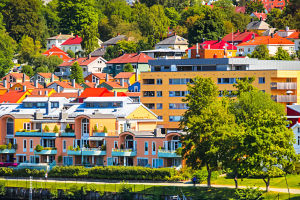In the context of social development, the urbanization process is advancing rapidly, making the status of architecture in the city very important. In every city, buildings of different shapes and images stand tall and proud.
Urban complexes serve multiple functions, providing leisure, entertainment, and office space. They have the advantages of high efficiency, large construction area, and a large number of participants, making them an important symbol of urban prosperity.
Urban architecture plays a vital role in modern cities. It is not only the landmark building of the city but also the embodiment of urban culture and a witness of history.
When designing urban architecture, it is necessary to take into account the aesthetic value of the building itself, while meeting the functional needs of the city.
Aesthetic value is an essential aspect of architectural design. In cities, the appearance and shape of buildings have a direct impact on the city's image. Well-designed buildings can make people feel happy and comfortable, enhancing the cultural atmosphere and humanistic value of the city.
For example, the Eiffel Tower in France has become a landmark in Paris not only because of its height and unique structure but also because of the cultural and historical value it represents. Therefore, in the design of urban architecture, the consideration of aesthetic value must be given priority.
The designers must consider two points when designing urban architecture in space. One is the visual effect. It should be designed as art to attract people's attention. The second is to provide people with visual continuity and fluidity in design, arousing people's consciousness and emotion, thereby realizing the charm of space art.
The characteristics of a city should be the perfect combination of its regional culture and specific architectural elements, making architecture and human activities integrated. From this point of view, architectural design is not only the design of the building itself but also the design of the space environment around the building.
In addition to the aesthetic value and spatial design, the design of urban buildings also needs to take into account many other factors. One of the essential factors is functionality.
Urban buildings usually need to meet a variety of different functional requirements, such as residence, business, office, culture, education, etc. In the design, it is necessary to rationally plan the spatial layout and use methods according to different functional requirements to achieve the optimal effect.
At the same time, the design of urban buildings also needs to take into account social needs and human health. Urban architecture should provide residents with a healthy, safe, and comfortable living and working environment, promoting the harmonious development of society.
Additionally, urban architecture should also take into account the needs of different groups of people, such as the elderly, the disabled, children, etc., to ensure the inclusiveness of urban architecture.
Urban architecture is an essential part of modern cities and plays a vital role in shaping the city's image and culture.
The designers of urban architecture should consider aesthetic value, spatial design, functionality, and social needs, creating buildings that are not only beautiful but also meet the needs of the city and its inhabitants. By doing so, urban architecture can contribute to the harmonious development of society and create a better living environment for all.


